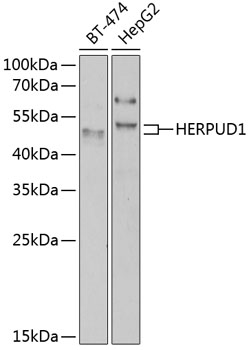Signal Transduction Antibodies 3
Anti-HERPUD1 Antibody (CAB7048)
- SKU:
- CAB7048
- Product Type:
- Antibody
- Reactivity:
- Human
- Reactivity:
- Mouse
- Reactivity:
- Rat
- Host Species:
- Rabbit
- Isotype:
- IgG
- Antibody Type:
- Polyclonal Antibody
- Research Area:
- Signal Transduction
Description
| Antibody Name: | Anti-HERPUD1 Antibody |
| Antibody SKU: | CAB7048 |
| Antibody Size: | 20uL, 50uL, 100uL |
| Application: | WB |
| Reactivity: | Human, Mouse, Rat |
| Host Species: | Rabbit |
| Immunogen: | Recombinant fusion protein containing a sequence corresponding to amino acids 1-240 of human HERPUD1 (NP_055500.1). |
| Application: | WB |
| Recommended Dilution: | WB 1:500 - 1:2000 |
| Reactivity: | Human, Mouse, Rat |
| Positive Samples: | BT-474, HepG2 |
| Immunogen: | Recombinant fusion protein containing a sequence corresponding to amino acids 1-240 of human HERPUD1 (NP_055500.1). |
| Purification Method: | Affinity purification |
| Storage Buffer: | Store at -20'C. Avoid freeze / thaw cycles. Buffer: PBS with 0.02% sodium azide, 50% glycerol, pH7.3. |
| Isotype: | IgG |
| Sequence: | MESE TEPE PVTL LVKS PNQR HRDL ELSG DRGW SVGH LKAH LSRV YPER PRPE DQRL IYSG KLLL DHQC LRDL LPKQ EKRH VLHL VCNV KSPS KMPE INAK VAES TEEP AGSN RGQY PEDS SSDG LRQR EVLR NLSS PGWE NISR PEAA QQAF QGLG PGFS GYTP YGWL QLSW FQQI YARQ YYMQ YLAA TAAS GAFV PPPS AQEI PVVS APAP APIH NQFP AENQ PANQ NAAP QVVV NPGA |
| Gene ID: | 9709 |
| Uniprot: | Q15011 |
| Cellular Location: | Endoplasmic reticulum membrane, Multi-pass membrane protein |
| Calculated MW: | 26kDa/40kDa/43kDa |
| Observed MW: | 44kDa |
| Synonyms: | HERPUD1, HERP, Mif1, SUP |
| Background: | The accumulation of unfolded proteins in the endoplasmic reticulum (ER) triggers the ER stress response. This response includes the inhibition of translation to prevent further accumulation of unfolded proteins, the increased expression of proteins involved in polypeptide folding, known as the unfolded protein response (UPR), and the destruction of misfolded proteins by the ER-associated protein degradation (ERAD) system. This gene may play a role in both UPR and ERAD. Its expression is induced by UPR and it has an ER stress response element in its promoter region while the encoded protein has an N-terminal ubiquitin-like domain which may interact with the ERAD system. This protein has been shown to interact with presenilin proteins and to increase the level of amyloid-beta protein following its overexpression. Alternative splicing of this gene produces multiple transcript variants encoding different isoforms. The full-length nature of all transcript variants has not been determined. |
| UniProt Protein Function: | HERPUD1: Component of the endoplasmic reticulum quality control (ERQC) system also called ER-associated degradation (ERAD) involved in ubiquitin-dependent degradation of misfolded endoplasmic reticulum proteins. Could enhance presenilin-mediated beta-amyloid protein 40 generation. 3 isoforms of the human protein are produced by alternative splicing. |
| UniProt Protein Details: | Protein type:Membrane protein, multi-pass; Membrane protein, integral Chromosomal Location of Human Ortholog: 16q13 Cellular Component: endoplasmic reticulum membrane; membrane; endoplasmic reticulum Biological Process: ubiquitin-dependent protein catabolic process; endoplasmic reticulum calcium ion homeostasis; unfolded protein response, activation of signaling protein activity; cellular protein metabolic process; positive regulation of protein binding; regulation of protein ubiquitination; unfolded protein response; negative regulation of caspase activity; response to unfolded protein |
| NCBI Summary: | The accumulation of unfolded proteins in the endoplasmic reticulum (ER) triggers the ER stress response. This response includes the inhibition of translation to prevent further accumulation of unfolded proteins, the increased expression of proteins involved in polypeptide folding, known as the unfolded protein response (UPR), and the destruction of misfolded proteins by the ER-associated protein degradation (ERAD) system. This gene may play a role in both UPR and ERAD. Its expression is induced by UPR and it has an ER stress response element in its promoter region while the encoded protein has an N-terminal ubiquitin-like domain which may interact with the ERAD system. This protein has been shown to interact with presenilin proteins and to increase the level of amyloid-beta protein following its overexpression. Alternative splicing of this gene produces multiple transcript variants encoding different isoforms. The full-length nature of all transcript variants has not been determined. [provided by RefSeq, Jan 2013] |
| UniProt Code: | Q15011 |
| NCBI GenInfo Identifier: | 3123034 |
| NCBI Gene ID: | 9709 |
| NCBI Accession: | Q15011.1 |
| UniProt Secondary Accession: | Q15011,O60644, Q6IAN8, Q96D92, E9PGD1, |
| UniProt Related Accession: | Q15011 |
| Molecular Weight: | 391 |
| NCBI Full Name: | Homocysteine-responsive endoplasmic reticulum-resident ubiquitin-like domain member 1 protein |
| NCBI Synonym Full Names: | homocysteine-inducible, endoplasmic reticulum stress-inducible, ubiquitin-like domain member 1 |
| NCBI Official Symbol: | HERPUD1 |
| NCBI Official Synonym Symbols: | SUP; HERP; Mif1 |
| NCBI Protein Information: | homocysteine-responsive endoplasmic reticulum-resident ubiquitin-like domain member 1 protein; MMS-inducible; methyl methanesulfonate (MMF)-inducible fragment protein 1; homocysteine-inducible endoplasmic reticulum stress-inducible ubiquitin-like domain member 1 protein |
| UniProt Protein Name: | Homocysteine-responsive endoplasmic reticulum-resident ubiquitin-like domain member 1 protein |
| UniProt Synonym Protein Names: | Methyl methanesulfonate (MMF)-inducible fragment protein 1 |
| Protein Family: | Homocysteine-responsive endoplasmic reticulum-resident ubiquitin-like domain member 1 protein |
| UniProt Gene Name: | HERPUD1 |
| UniProt Entry Name: | HERP1_HUMAN |
View AllClose







